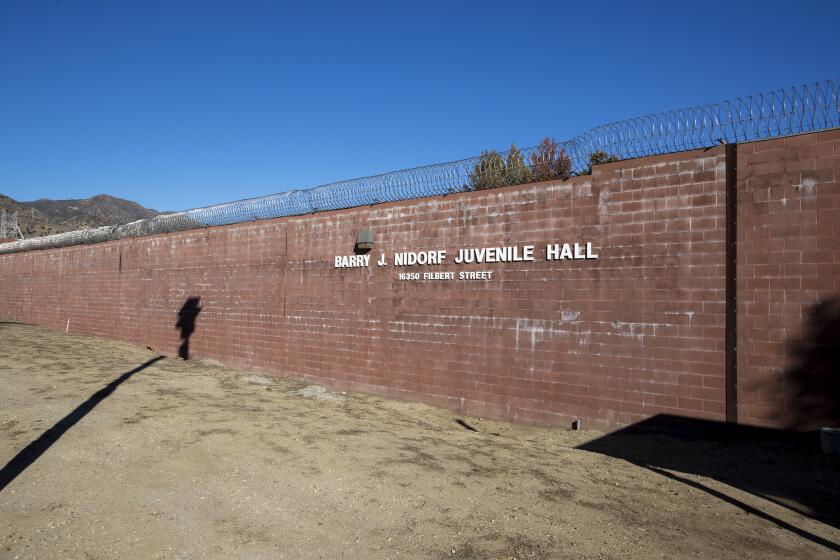Editorial: Sexual assaults, probation’s meltdown and L.A. County governance are connected

Under a proposal that goes before the Los Angeles County Board of Supervisors on Tuesday, reserve sheriff‘s deputies would help staff the county’s two chaotic juvenile halls, a third hall would reopen, and the county chief executive officer would have emergency powers to take additional actions to save the foundering Probation Department.
The 10-page plan by county CEO Fesia Davenport was unveiled after close of business Friday, less than two weeks before a May 9 court hearing on a lawsuit by the California Department of Justice to compel the county to comply with a 2021 settlement agreement over the abysmal conditions at the juvenile halls. Shortly thereafter will come a state board’s decision on whether to close the county’s two juvenile halls, and the closure of the state’s juvenile justice program, returning hundreds of youths convicted of serious crimes to their home counties.
At first blush it might not seem that the sweeping measure to keep juvenile halls operating has much to do with a mundane subject such as the structure and management practices of the Board of Supervisors. Or the shocking revelation that the county might be on the hook for up to $3 billion in damages to hundreds of people who allegedly were molested as children over the course of several decades while they were living directly under county protection and supervision.
But in fact these things are intimately related.
L.A. County has hired 11 law firms to deal with as many as 3,000 plaintiffs who allege that they were sexually abused at county facilities.
The alleged sexual abuse took place at juvenile halls, probation camps, foster homes and MacLaren Children’s Center, an El Monte facility for children removed from their homes by the county Department of Children and Family Services. Reports of mental, physical and sexual abuse at MacLaren were so rampant, liability was potentially so great and efforts to correct the problems were so ineffectual that the county closed it 20 years ago after a class-action lawsuit.
Similar allegations of sexual and other abuse dogged the juvenile halls, which house youths accused of crimes before adjudication, and camps, where some juveniles are sentenced to remain for several weeks or months. But most remained open until caseloads dropped.
The Board of Supervisors has long struggled to find the best way to manage its most crisis-ridden operations, including the Probation Department and DCFS. In most other counties, supervisors don’t interfere with department operations. In L.A. County, critics charge that supervisors cause intractable problems by meddling, micromanaging and barging through the chain of command. The supervisors repeatedly express their belief that the two departments, and the children they’re supposed to help, are too important to leave to underlings.
After a previous county chief executive officer retired in 2007, the board could find no one to take the job because of its reputation for interference. It hired a new CEO that year only after agreeing to butt out of department affairs and stick with oversight and policymaking.
Los Angeles County juvenile halls have been cited for unconstitutionally poor conditions for decades. It’s too late to save them.
But the board chafed at its more limited role and retook direct control of Probation and DCFS in 2011, and later all departments.
For Probation, at least, the new/old arrangement has gone poorly. Davenport’s proposal would now put her more firmly in charge of juvenile probation as the department faces an existential emergency.
Less board meddling and more executive emergency powers may well have been part of an effective prescription had it come forward in recent years. Now, though, with state agencies breathing down the supervisors’ necks, it’s probably too late.
The Justice Department and the state corrections board should look beyond these last-minute fixes and remember that there are hundreds of people alleging county mistreatment reaching back into the 1970s. Even if past micromanaging by the Board of Supervisors led to the chaos that abetted the mismanagement and injuries, and even if Davenport’s proposal would curtail it, the county will continue to have labor contracts that put the interests of employees before juveniles, and an entrenched department culture that may take years to correct.
Earlier this year, after some haggling, the supervisors agreed to seek an assessment of its governance and management practices and recommendations for improvement. That’s a good move, but it will be August before the board even considers potential contractors to undertake the study. If only the board had moved with the same swiftness on its governance problem as it is now trying to do with its costly juvenile justice crisis.
More to Read
A cure for the common opinion
Get thought-provoking perspectives with our weekly newsletter.
You may occasionally receive promotional content from the Los Angeles Times.












